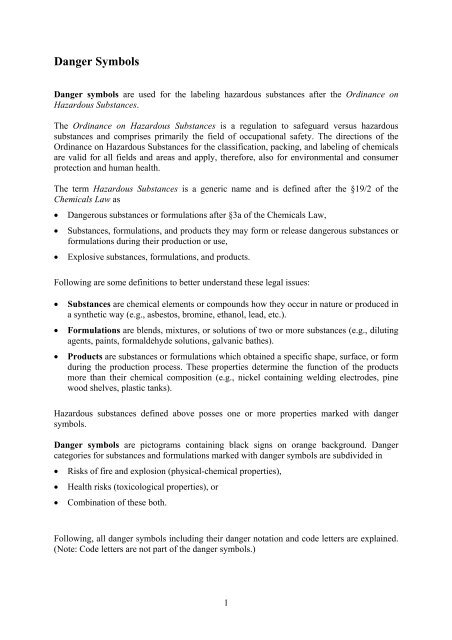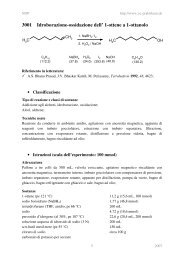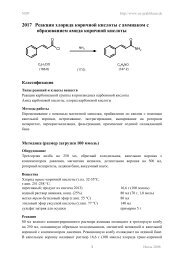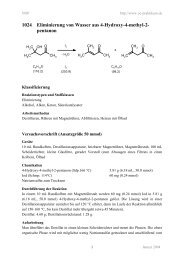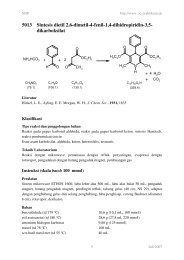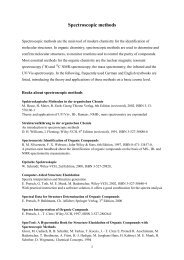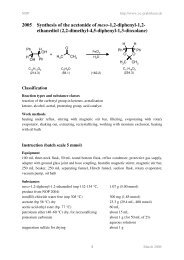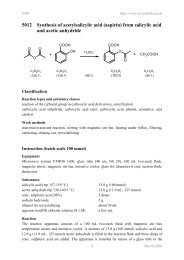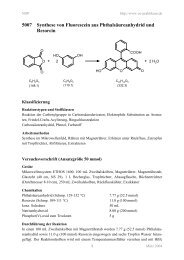Danger Symbols - kriemhild
Danger Symbols - kriemhild
Danger Symbols - kriemhild
Create successful ePaper yourself
Turn your PDF publications into a flip-book with our unique Google optimized e-Paper software.
<strong>Danger</strong> <strong>Symbols</strong><br />
<strong>Danger</strong> symbols are used for the labeling hazardous substances after the Ordinance on<br />
Hazardous Substances.<br />
The Ordinance on Hazardous Substances is a regulation to safeguard versus hazardous<br />
substances and comprises primarily the field of occupational safety. The directions of the<br />
Ordinance on Hazardous Substances for the classification, packing, and labeling of chemicals<br />
are valid for all fields and areas and apply, therefore, also for environmental and consumer<br />
protection and human health.<br />
The term Hazardous Substances is a generic name and is defined after the §19/2 of the<br />
Chemicals Law as<br />
• <strong>Danger</strong>ous substances or formulations after §3a of the Chemicals Law,<br />
• Substances, formulations, and products they may form or release dangerous substances or<br />
formulations during their production or use,<br />
• Explosive substances, formulations, and products.<br />
Following are some definitions to better understand these legal issues:<br />
• Substances are chemical elements or compounds how they occur in nature or produced in<br />
a synthetic way (e.g., asbestos, bromine, ethanol, lead, etc.).<br />
• Formulations are blends, mixtures, or solutions of two or more substances (e.g., diluting<br />
agents, paints, formaldehyde solutions, galvanic bathes).<br />
• Products are substances or formulations which obtained a specific shape, surface, or form<br />
during the production process. These properties determine the function of the products<br />
more than their chemical composition (e.g., nickel containing welding electrodes, pine<br />
wood shelves, plastic tanks).<br />
Hazardous substances defined above posses one or more properties marked with danger<br />
symbols.<br />
<strong>Danger</strong> symbols are pictograms containing black signs on orange background. <strong>Danger</strong><br />
categories for substances and formulations marked with danger symbols are subdivided in<br />
• Risks of fire and explosion (physical-chemical properties),<br />
• Health risks (toxicological properties), or<br />
• Combination of these both.<br />
Following, all danger symbols including their danger notation and code letters are explained.<br />
(Note: Code letters are not part of the danger symbols.)<br />
1
Inflammable Substances<br />
Inflammable substances comprise the sub-groups explosive substances, oxidizing substances,<br />
extremely flammable substances, and highly flammable substances. Flammable substances<br />
belong also to the category of inflammable substances, but the use of a danger symbol is not<br />
necessary for these substances.<br />
Explosive<br />
Code Letter: E<br />
Substances and formulations marked with the danger notation “explosive” can explode by hit,<br />
friction, heating, fire, and other ignition sources even without atmospheric oxygen. Explosion<br />
will be triggered by a vigorous reaction of the substance. High energy is released thereby<br />
along with propagation of shock waves. The risk of explosion can be determined after the<br />
methods given in the Law for Explosive Substances.<br />
In the laboratory mixtures of strongly oxidizing compounds with flammable or reducing<br />
substances can be explosive. For instance, fuming nitric acid reacts with an explosion with<br />
solvents like acetone, diethylether, ethanol, etc. Production or working with explosives<br />
necessitates particular knowledge and practical experiences as well as special safety<br />
measures. While working with these substances the quantities must be kept small for ahndling<br />
as well as for stockpiling.<br />
The main R-Phrases for explosive substances are R1, R2, and R3.<br />
An example for the above described properties is 2,4,6-trinitro toluene (TNT).<br />
Oxidizing<br />
Code Letter: O<br />
Substances and formulations marked with the danger notation “oxidizing” are usually not<br />
combustible. But in contact with combustible or highly flammable substances they can<br />
increase the risk and the violence of a fire significantly. In many cases they are salt-like<br />
inorganic substances with strongly oxidizing properties and organic peroxides.<br />
The main R-Phrases for oxidizing substances are R7, R8, and R9.<br />
Examples for the above described properties are potassium chlorate and potassium<br />
permanganate, but also concentrated nitric acid.<br />
2
Extremely Flammable<br />
Code Letter: F +<br />
Substances and formulations marked with the danger notation “extremely flammable” have as<br />
liquids a very low ignition points (below 0 °C) and low boiling points resp. initial boiling<br />
points (below + 35 °C). Extremely flammable gaseous substances easily form with air an<br />
explosive mixture under normal conditions.<br />
The main R-Phrase for extremely flammable substances is R12.<br />
Examples for the above described properties are diethylether (liquids) and hydrogen resp.<br />
propane (gases).<br />
Highly Flammable<br />
Code Letter: F<br />
Substances and formulations marked with the danger notation “highly flammable” are subject<br />
for self-heating and ignition under usual atmospheric conditions, or they have low ignition<br />
points (below + 21 °C). Some highly flammable substances produce extremely flammable<br />
gases under the influence of humidity. Substances they may heat up in air at room<br />
temperature without additional energy supply and finally ignite are also labeled as “highly<br />
flammable”.<br />
The main R-Phrase for highly flammable substances is R11.<br />
Examples for the above described properties are acetone and sodium metal, which are<br />
regularly used in laboratories as solvent resp. drying agent.<br />
Flammable<br />
Code Letter: not given<br />
There is no danger symbol needed in order to label substances and formulations with the<br />
danger notation “flammable”. Liquid substances and formulations having an ignition point<br />
between + 21 °C and + 55 °C are categorized as “flammable”.<br />
The main R-Phrase for flammable substances is R10.<br />
An example for the above described properties is oil of turpentine.<br />
3
Substances Hazardous to Health<br />
The categorization of substances and formulations according to their toxicological properties<br />
comprises acute and long-term effects independent whether these effects are caused from one<br />
single, repeated, or long-term exposition. An important parameter to assess the acute toxicity<br />
of a substance is its LD50 value determined in animal experiments. The LD50 value reflects the<br />
lethal dose in mg per kg body weight which would cause the death of 50% of the test animals<br />
within 14 days after one single administration. Due to the test design one distinguish between<br />
LD50 oral (p. o. = per os) uptake and digestion through the gastrointestinal system, and LD50<br />
dermal in case of uptake through the skin. Besides these both there exists also a lethal<br />
concentration LC50 pulmonary (inhalation). It reflects the concentration of a pollutant in air<br />
(mg/L) which would cause death of 50% of the test animals within 14 days after an exposition<br />
of four hours.<br />
The term “substances hazardous to health” includes the sub-groups “very toxic substances”,<br />
“toxic substances”, and “harmful substances”.<br />
Very Toxic<br />
Code Letter: T +<br />
Substances and formulations marked with the danger notation “very toxic” can cause<br />
significant acute or chronicle health damages and even death at very low concentrations if<br />
taken up by inhalation, ingestion, or in contact with the skin.<br />
A substance is categorized as vey toxic if the following criteria of the Ordinance on<br />
Hazardous Substances are fulfilled:<br />
LD50 oral (rat) ≤ 25 mg/kg b.w. (b.w. = body weight)<br />
LD50 dermal (rat or rabbit) ≤ 50 mg/kg b.w.<br />
LC50 pulmonary (rat) for aerosols/dusts ≤ 0.25 mg/L<br />
LC50 pulmonary (rat) for gases/vapors ≤ 0.50 mg/L<br />
The main R-Phrases for very toxic substances are R26, R27, and R28.<br />
Examples for the above described properties are potassium cyanide, hydrogen sulphide,<br />
nitrobenzene, and atropine (the naturally produced alkaloid in deadly nightshade).<br />
4
Toxic<br />
Code Letter: T<br />
Substances and formulations marked with the danger notation “toxic” can cause acute or<br />
chronicle health damages and even death at low concentrations if taken up by inhalation,<br />
ingestion, or in contact with the skin.<br />
A substance is categorized as toxic if the following criteria of the Ordinance on Hazardous<br />
Substances are fulfilled:<br />
LD50 oral (rat) 25 – 200 mg/kg b.w.<br />
LD50 dermal (rat or rabbit) 50 – 400 mg/kg b.w.<br />
LC50 pulmonary (rat) for aerosols/dusts 0.25 – 1 mg/L<br />
LC50 pulmonary (rat) for gases/vapors 0.50 – 2 mg/L<br />
The main R-Phrases for toxic substances are R23, R24, and R25.<br />
Substances and formulations having the properties<br />
carcinogenic (main R-Phrases: R45 and R40),<br />
mutagenic (main R-Phrase: R47),<br />
toxic for reproduction (main R-Phrases: R46 and R40), or<br />
other chronically damaging properties (main R-Phrase: R48)<br />
are marked with the danger symbol for “toxic substances” and the code letter T.<br />
Carcinogenic substances can cause cancer or increase the cancer incidence if taken up by<br />
inhalation, ingestion, or in contact with the skin.<br />
Examples for the above described properties are solvents like methanol (toxic) and benzene<br />
(toxic, carcinogenic).<br />
Harmful<br />
Code Letter: Xn<br />
Substances and formulations marked with the danger notation “harmful” have a moderate risk<br />
of health damages if taken up by inhalation, ingestion, or in contact with the skin.<br />
A substance is categorized as harmful if the following criteria of the Ordinance on Hazardous<br />
Substances are fulfilled:<br />
5
LD50 oral (rat) 200 – 2000 mg/kg b.w.<br />
LD50 dermal (rat or rabbit) 400 – 2000 mg/kg b.w.<br />
LC50 pulmonary (rat) for aerosols/dusts 1 – 5 mg/L<br />
LC50 pulmonary (rat) for gases/vapors 2 – 20 mg/L<br />
The main R-Phrases for harmful substances are R20, R21, and R22.<br />
Substances and formulations having the properties<br />
carcinogenic (main R-Phrases: R45 and R40),<br />
mutagenic (main R-Phrase: R47),<br />
toxic for reproduction (main R-Phrases: R46 and R40), or<br />
other chronically damaging properties (main R-Phrase: R48)<br />
which are not notated as toxic, will be marked with the danger symbol for “harmful<br />
substances” and the code letter Xn.<br />
Further substances, which are<br />
suspected to have carcinogenic properties,<br />
will also be marked with the danger symbol for “harmful substances” and the code letter Xn.<br />
Sensitizing substances (main R-Phrases: R42 and R43)<br />
are labeled according to their spectrum of effects either with the danger symbol for “harmful<br />
substances” and the code letter Xn or with the danger symbol for “irritant substances” and the<br />
code letter Xi.<br />
Substances suspected to have carcinogenic properties can cause cancer with high probability<br />
if taken up by inhalation, ingestion, or in contact with the skin.<br />
Examples for the above described properties are solvents like 1,2-ethane-1,2-diol = ethylene<br />
glycol = glycol (harmful) and dichloromethane (harmful, suspected to be carcinogenic).<br />
Tissue Destroying Substances<br />
The term “tissue destroying substances” includes the sub-groups “corrosive substances” and<br />
“irritant substances”.<br />
Corrosive<br />
Code Letter: C<br />
Substances and formulations with the damage notation “corrosive” destroy living tissues. If a<br />
substance destroys the healthy and intact skin of test animals in its whole thickness or this<br />
property is predictable due to the chemical characteristics of the test substances, e.g., acids<br />
(pH < 2) and bases (pH > 11.5), then it will be marked as corrosive.<br />
6
The main R-Phrases for corrosive substances are R34 and R35.<br />
Examples for the above described properties are mineral acids like hydrochloric acid and<br />
sulfuric acid as well as bases like sodium hydroxide solutions (caustic-soda solutions) (><br />
2%).<br />
Irritant<br />
Code Letter: Xi<br />
Substances and formulations with the damage notation “irritant” are not corrosive. But they<br />
can cause inflammation in contact with skin or mucous membranes.<br />
The main R-Phrases for irritant substances are R36, R37, R38, and R41.<br />
Examples for the above described properties are isopropyl amine, calcium chloride and<br />
diluted acids and bases.<br />
<strong>Danger</strong>ous for the Environment Code Letter: N<br />
<strong>Danger</strong>ous for the Environment<br />
Code Letter: N<br />
Substances and formulations with the damage notation “dangerous for the environment” can<br />
cause immediate or delayed adverse effects on one or more environmental compartments<br />
(water, soil, air, plants, micro organisms) and lead to ecological disturbances.<br />
The main R-Phrases for environmentally hazardous substances are R50, R51, R52, and R53.<br />
Examples for the above described properties are tributyl tin chloride, tetrachloro methane,<br />
and petroleum hydrocarbons like pentane and petroleum benzine.<br />
7


